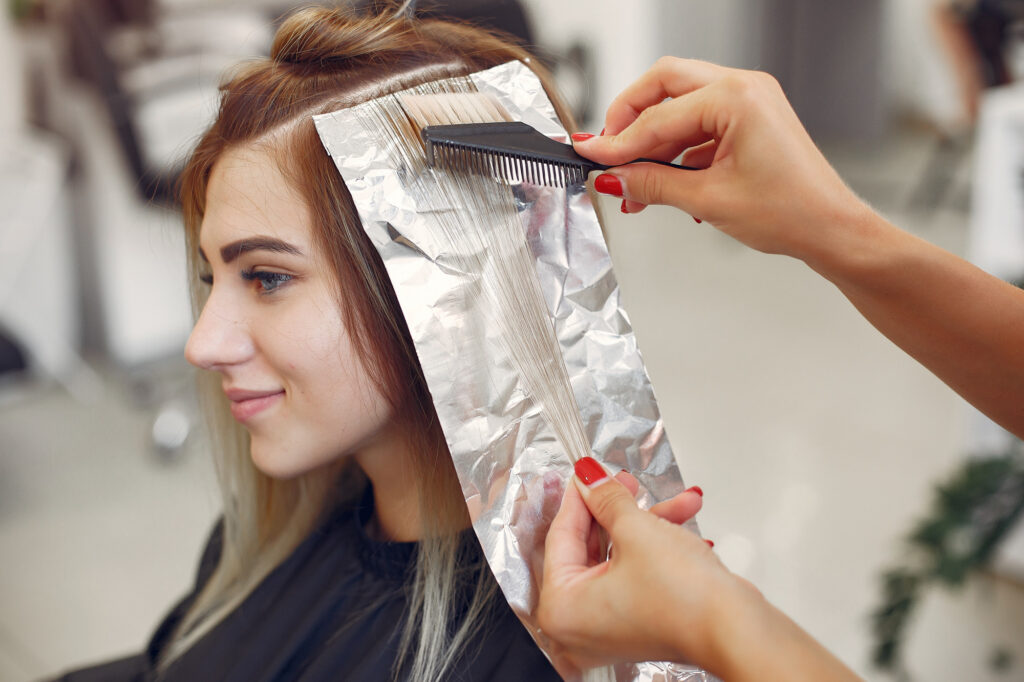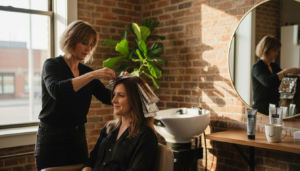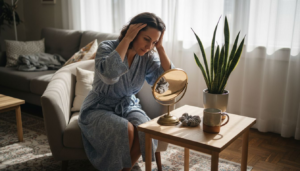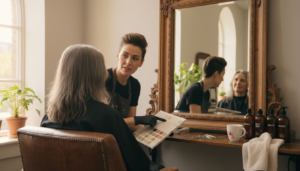Caring for color-treated hair takes more than luck with your shampoo and conditioner. Hot tools can reach over 400 degrees Fahrenheit and traditional shampoos strip color faster than you might think. Most people assume professional products are a splurge, but they often end up saving you money by making your color last longer and look better. There is a better way and it starts with a smarter routine.
Table of Contents
- Step 1: Choose The Right Products For Color Care
- Step 2: Wash Your Hair With Color-Safe Shampoo
- Step 3: Moisturize With Deep Conditioning Treatments
- Step 4: Protect Color With Heat And UV Shields
- Step 5: Schedule Regular Maintenance And Touch-Ups
Quick Summary
| Key Point | Explanation |
|---|---|
| 1. Use sulfate-free shampoos | Conventional shampoos can strip color, leading to fading. Select sulfate-free options for color preservation. |
| 2. Wash hair with cool water | Hot water opens hair cuticles, causing color loss. Wash color-treated hair with lukewarm or cool water instead. |
| 3. Apply deep conditioning weekly | Deep conditioning restores moisture and repairs damage. Use specifically formulated products for color-treated hair to enhance health. |
| 4. Use heat protectants before styling | Heat from styling tools can damage color-treated hair. Always apply a thermal protective product before using heat. |
| 5. Schedule regular salon touch-ups | Professional touch-ups every 4-6 weeks maintain color vibrancy and health. Consistent maintenance helps avoid excessive damage. |
Step 1: Choose the Right Products for Color Care
Selecting the right products is foundational to maintaining vibrant, healthy color-treated hair. Your hair color represents a significant investment of time and money, which means protecting it requires strategic product selection tailored to your specific hair type and color treatment.
Color-treated hair demands specialized care that goes beyond standard hair care routines. Sulfate-free shampoos are essential because traditional shampoos can strip color molecules, causing rapid fading and dulling of your carefully chosen shade. Professional colorists recommend looking for products specifically designed for color preservation, which typically contain gentler cleansing agents and additional protective ingredients.
Understanding your hair’s unique characteristics plays a crucial role in product selection. Fine, delicate hair requires lightweight, volumizing color care products that won’t weigh down strands, while thick or coarse hair benefits from more intensive, moisture-rich formulations. Research from the National Institutes of Health confirms that hair porosity significantly influences product absorption and effectiveness.
When shopping for color care products, prioritize items that offer multiple benefits. Seek out formulations that provide:
- UV protection to prevent sun-induced color fading
- Keratin or protein reinforcement to strengthen hair structure
- Moisture retention without heavy buildup
- Color-locking technology to extend vibrancy
Professional salon-grade products typically outperform drugstore alternatives because they contain more concentrated, high-quality ingredients.
This table compares product feature options to consider when choosing hair care products for color-treated hair, allowing you to match the best benefits to your hair type and needs.
| Product Feature | Purpose | Best For |
|---|---|---|
| Sulfate-Free Formula | Prevents color stripping and fading | All color-treated hair |
| UV Protection | Shields from sun-induced color fading | Hair exposed to sunlight regularly |
| Keratin/Protein Reinforcement | Strengthens hair and repairs damage | Chemically processed or fragile hair |
| Moisture Retention | Maintains hydration without buildup | Thick, coarse, or dry hair |
| Lightweight/V0lumizing | Adds body without heaviness | Fine or limp hair |
| Color-Locking Technology | Extends color longevity and vibrancy | Recently colored or vivid shades |
To verify you’ve chosen the right products, pay attention to how your hair responds within the first few weeks. Healthy color-treated hair should maintain its shine, feel soft to the touch, and show minimal signs of color fading. If you notice excessive dryness, brittleness, or rapid color loss, it’s time to reassess and potentially consult a professional colorist for personalized recommendations.
Here is a checklist table to help you verify if your color-treated hair care routine is effective, as described throughout the guide.
| Verification Criteria | What to Look For | Action if Not Met |
|---|---|---|
| Shine & Luster | Hair appears shiny and vibrant | Adjust products used or washing routine |
| Softness | Hair feels soft and smooth to the touch | Increase deep conditioning or moisture treatments |
| Minimal Color Fading | Color looks fresh and stable between touch-ups | Reassess shampoo type and washing frequency |
| Low Breakage | Less breakage or split ends observed | Use more intensive conditioners or repair treatments |
| Even Color Tone | Color remains consistent from roots to ends | Schedule touch-ups or consult your stylist |
| Low Frizz & Brittleness | Hair feels resilient, not dry or frizzy | Add leave-in products or reduce heat exposure |
| Minimal Oil Buildup | Scalp feels clean, not greasy | Focus cleansing on scalp and adjust product quantity |
Step 2: Wash Your Hair with Color-Safe Shampoo
Washing color-treated hair requires a strategic approach that preserves your color investment while maintaining hair health. The washing process is more nuanced than standard hair cleansing, demanding careful technique and specialized products to prevent premature color fading and maintain vibrant, lustrous results.
Water temperature plays a critical role in color preservation. Hot water opens hair cuticles, allowing color molecules to escape more quickly, which accelerates color deterioration. Instead, opt for lukewarm or cool water during your washing routine. This temperature approach helps seal the hair cuticle, locking in color and preventing unnecessary pigment loss.
Applying color-safe shampoo requires a gentle touch. Begin by thoroughly wetting your hair, then dispense a small amount of sulfate-free, color-protecting shampoo into your palm. Research from the Journal of Cosmetic Science demonstrates that gentle, targeted application minimizes color stripping and maintains hair integrity.
Massage the shampoo primarily into your scalp using fingertips, not fingernails. The goal is to cleanse the scalp and roots without excessive friction that could cause color breakdown. Allow the shampoo to naturally flow through the length of your hair during rinsing, which prevents unnecessary mechanical stress on color-treated strands.
Consider these key washing strategies for optimal color maintenance:
- Limit washing frequency to 2-3 times per week
- Use dry shampoo between washes to manage oil and refresh style
- Focus cleansing on the scalp, not the entire hair length
- Rinse thoroughly with cool water to seal hair cuticles
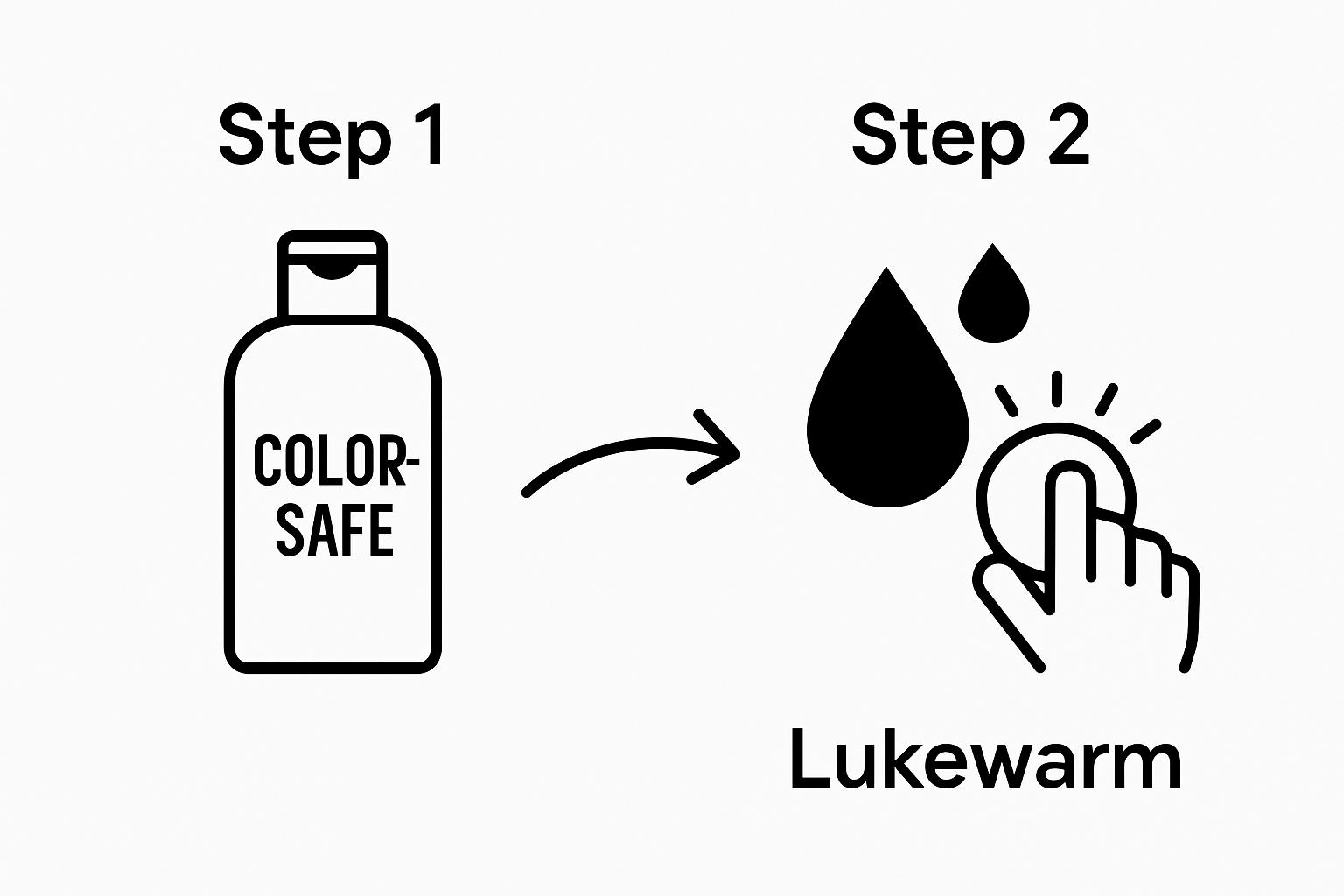
Professional colorists recommend avoiding daily washing, which can accelerate color fade and strip natural protective oils. If you have an active lifestyle or tend to sweat frequently, use dry shampoo or rinse with water between full washing sessions.
Verify your washing technique’s effectiveness by observing your hair’s appearance and texture. Healthy color-treated hair should maintain its shine, feel smooth, and display minimal color bleeding or fading. Any significant color loss or dullness indicates the need to adjust your washing approach or potentially consult a professional stylist for personalized guidance.
Step 3: Moisturize with Deep Conditioning Treatments
Deep conditioning treatments represent a critical intervention for color-treated hair, providing essential moisture and structural repair that goes beyond standard daily conditioning. Color processing inherently damages hair’s protective cuticle, making intensive moisturization not just a luxury, but a necessary maintenance strategy to preserve your hair’s health and vibrancy.
Timing and frequency are crucial when incorporating deep conditioning into your hair care routine. Color-treated hair typically requires weekly deep conditioning treatments, though hair texture and damage level can influence this recommendation. Individuals with more porous or chemically processed hair might benefit from more frequent intensive moisture sessions.
Application technique matters significantly. After shampooing, gently towel-dry your hair to remove excess water, leaving it slightly damp. This moisture helps the conditioning treatment penetrate more effectively. Research from the International Journal of Cosmetic Science confirms that proper application enhances the treatment’s ability to restore and protect hair fibers.
Select a deep conditioning treatment specifically formulated for color-treated hair. Look for ingredients like keratin, natural oils, and proteins that reconstruct hair’s internal structure while providing intense hydration. Avoid products containing sulfates or harsh chemicals that could potentially strip your color or cause further damage.
Consider these strategic deep conditioning approaches:
- Apply treatment from mid-length to ends, avoiding the scalp
- Use a wide-toothed comb to distribute product evenly
- Allow treatment to sit for 10-15 minutes under a shower cap
- Rinse with cool water to seal hair cuticles
Professional stylists recommend using heat to enhance treatment absorption. After applying the conditioning product, cover your hair with a warm towel or use a conditioning heat cap. The gentle warmth helps the moisturizing ingredients penetrate deeper into the hair shaft, maximizing repair and protection.
Verify the effectiveness of your deep conditioning routine by assessing your hair’s texture and appearance. Properly moisturized, color-treated hair should feel soft, appear shiny, and show minimal signs of breakage or dryness. If your hair continues to feel brittle or lacks luster, consider consulting a professional stylist to customize a more targeted conditioning strategy.
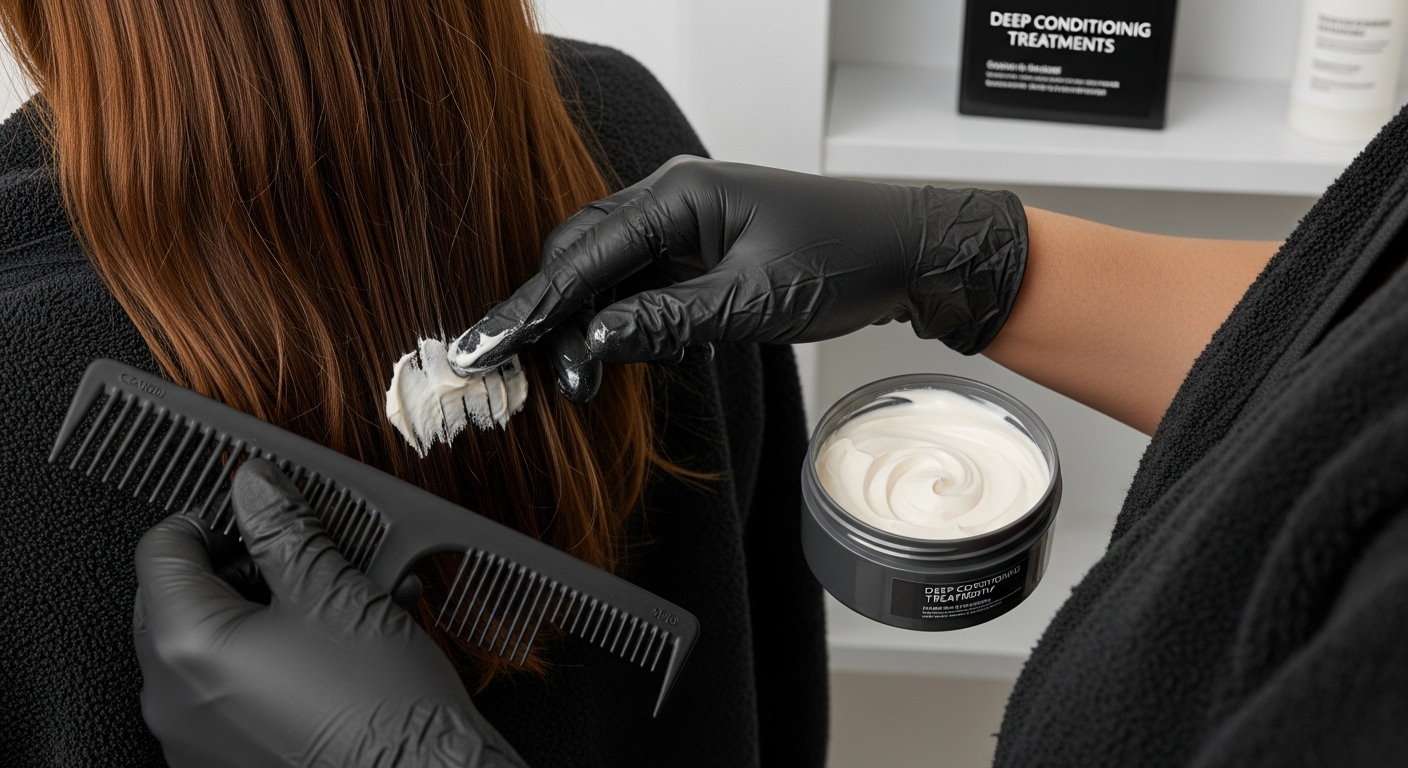
Step 4: Protect Color with Heat and UV Shields
Protecting color-treated hair from heat and ultraviolet radiation is a critical strategy for maintaining vibrant, long-lasting color and preventing premature damage. Color molecules are inherently fragile, making them vulnerable to environmental stressors that can cause rapid fading and structural breakdown.
Heat styling tools represent a significant threat to color-treated hair. Flat irons, curling wands, and blow dryers can reach temperatures exceeding 400 degrees Fahrenheit, which can instantly strip color and compromise hair’s structural integrity. Professional stylists recommend applying a thermal protection product before any heat styling to create a protective barrier that shields hair from extreme temperatures.
Research published in Biomimetics highlights the importance of using protective compounds that can absorb and neutralize harmful radiation. When selecting heat and UV protection products, prioritize formulations containing natural antioxidants and polymers designed to create a microscopic shield around each hair strand.
Applying heat and UV protection requires a strategic approach. Start with a small amount of protective spray or serum, focusing on distributing the product evenly from mid-length to ends. Avoid saturating the roots, which can lead to excess oil buildup. For maximum effectiveness, apply the product to damp hair before heat styling, allowing it to form a comprehensive protective layer.
Consider these essential protection strategies:
- Use heat styling tools on the lowest effective temperature setting
- Apply heat protectant before every styling session
- Wear hats or use hair products with built-in UV protection outdoors
- Limit direct sun exposure during peak hours
- Reapply UV protection every two hours when spending extended time outside
Indoor lighting and electronic device screens also emit radiation that can gradually degrade hair color. Consider using leave-in products with broad-spectrum protection that shield against multiple types of environmental stressors. Some advanced formulations offer protection from infrared and blue light in addition to traditional UV radiation.
Verify your protection strategy’s effectiveness by monitoring your hair’s color vibrancy and overall health. Properly protected color-treated hair should maintain its rich tone, display minimal fading, and feel smooth and resilient. If you notice rapid color loss or increased brittleness, it might be time to consult a professional stylist and reassess your protective hair care routine.
Step 5: Schedule Regular Maintenance and Touch-ups
Maintaining color-treated hair requires a proactive approach to salon maintenance and professional touch-ups. Regular professional interventions are not merely a cosmetic luxury but a critical strategy for preserving your hair’s health, color vibrancy, and overall appearance.
Timing is everything when scheduling color maintenance. Most professional colorists recommend touch-up appointments every 4 to 6 weeks, depending on your specific hair growth rate and color type. Factors like natural hair color, desired shade, and individual hair growth patterns significantly influence the ideal touch-up frequency.
Research from hair care professionals emphasizes the importance of consistent professional care. During these maintenance sessions, your stylist can assess color evenness, address root growth, and perform specialized treatments that restore hair’s structural integrity after chemical processing.
Preparing for your maintenance appointment involves more than simply booking a time slot. Communicate openly with your stylist about your color history, previous treatments, and any changes in your hair’s texture or condition. Bring reference images that demonstrate your desired color outcome, and be prepared to discuss potential adjustments based on your hair’s current health.
Consider these strategic maintenance approaches:
- Document your color formula for consistent future applications
- Discuss potential color corrections or adjustments
- Request professional deep conditioning treatments
- Evaluate current hair health and potential structural damage
- Plan for gradual color transitions if considering significant changes
Between professional touch-ups, maintain your color’s vibrancy through at-home care strategies. Use color-depositing conditioners, avoid excessive washing, and protect your hair from environmental stressors. These interim maintenance techniques help extend the life of your professional color treatment and reduce the frequency of potentially damaging chemical processes.
Verify the success of your maintenance routine by assessing your hair’s overall appearance. Healthy, well-maintained color-treated hair should display consistent tone, minimal root regrowth, and a vibrant, lustrous finish. If you notice significant fading, uneven color, or excessive damage between appointments, it might be time to consult your stylist and adjust your maintenance strategy. Professional guidance ensures your color remains fresh, beautiful, and perfectly tailored to your individual style.
Transform Your Colored Hair With Expert Care and Stunning Results
You have learned the top strategies for protecting your color investment and keeping hair looking vibrant, but achieving true perfection often requires the touch of a seasoned professional. The challenges of rapid color fading, moisture loss, and proper maintenance are real—why settle for uncertainty or disappointing results at home?

Experience the expertise of the Joel C Ma Hair Studio team, where each visit starts with a personalized consultation and a care plan tailored to your unique color and style goals. Our stylists are artists with over 25 years of experience in advanced color techniques and restorative treatments, ensuring your hair remains healthy, shiny, and bold. Secure your best hair yet—book your premium color care service today and see the difference expert guidance can make. Don’t let your vibrant style fade when beautiful, lasting color is just an appointment away.
Frequently Asked Questions
What types of shampoos should I use for color-treated hair?
You should use sulfate-free shampoos specifically designed for color preservation to prevent color stripping and fading.
How often should I wash my color-treated hair?
Limit washing to 2-3 times per week to protect your color investment and allow natural oils to nourish your hair.
How can I deeply condition my color-treated hair effectively?
Apply a deep conditioning treatment weekly, focusing on the mid-lengths to ends, and consider using heat to enhance absorption.
What precautions should I take when using heat styling tools on colored hair?
Always apply a heat protectant before using heat styling tools, and use the lowest effective temperature to minimize damage and color fading.


